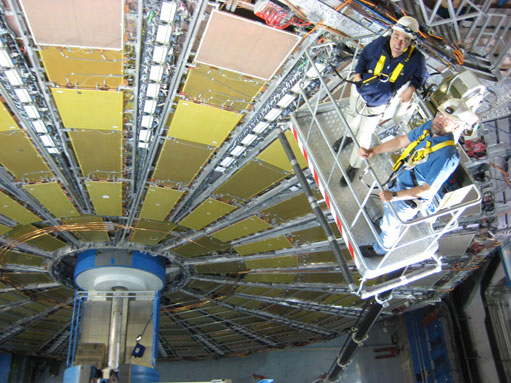
ATLAS e-News
23 February 2011
Last detector connected
22 July 2008

Marco Bruschi (left) and Vincent Hedberg on the cherry-picker
The LUCID detector, which will measure the luminosity of the collisions occurring in the centre of ATLAS, was among the last pieces of the detector to get approval. In fact, the small collaboration, based in Bologna, Italy; Alberta, Canada; Lund, Sweden; and at CERN, didn’t even begin building until February of last year.
LUCID is composed of two detectors that surround the beampipe, one on each side of ATLAS, at 17 metres from the collision point. Its commissioning started June 9th and 16th, when the last two pieces of the beampipe entered the cavern with detectors attached.
Vincent Hedberg, LUCID technical coordinator, and Marco Bruschi, project leader, are quick to downplay the challenges of their commissioning tasks when their detector has 40 channels compared to the millions of channels in other subdetectors. “They’d laugh us out of the house!” says Vincent. However, accessing their detector, 15 metres above the floor, in between the outer endcap muon chambers and endcap toroid magnet, was a feat in itself. “Vincent exaggerates a bit about how easy it is,” says Marco, “since the problem was to fit all the work into a very narrow allotted time, like in a Formula 1 pit stop.”
A portion of the beam shielding block is already in place on the beamline, half a cylinder with a flat top, resembling a bridge between the big muon wheel and the endcap toroid magnet. They built a platform on top of this as a work area. Without access by ladder or stairs, they had to commute to and from LUCID on cherry-picker cranes.
Connecting LUCID to all its services took more time than expected because other activities, such as the beampipe installation, were competing for work space and access to the cherry-pickers. Even so, they successfully connected the copper pipes to carry gas for detecting particles and water for cooling. They also hooked up the cables that will transmit the detector signals as well as the high and low voltage electricity that makes it run.
The bulk of the cabling was completed in the first two weeks, finishing around June 23rd, but a few difficult areas took a bit more time. According to Vincent, in an interview on July 2nd: “We finished with the last problem cable yesterday at nine o’clock.”
Testing began as soon as the first services were connected. As of July 15th, the cooling and gas systems, and high voltage were all working. “The only thing remaining is a broken LED electronics card on one side,” says Marco, “but that we will fix in the next few days. We are now preparing the read-out so that we can be fully prepared to catch the very first collisions from the LHC machine and provide luminosity measurement from day one!”

Katie McAlpineATLAS e-News
|